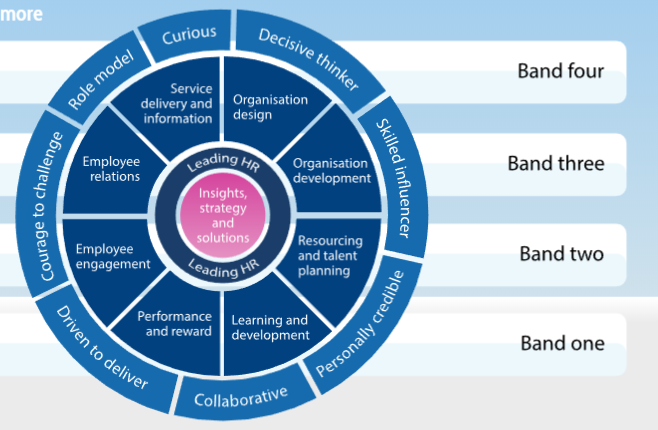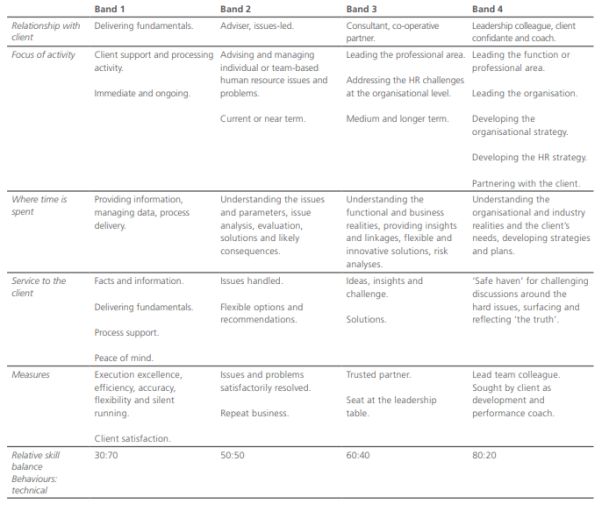What is HR Professionalism and how do You Ensure that You are Effective
| ✅ Paper Type: Free Essay | ✅ Subject: Human Resources |
| ✅ Wordcount: 1791 words | ✅ Published: 23rd Sep 2019 |
Contents
Being an effective and Efficient HR professional
CIPD Professional Map and Banding
Four concentric circles of HR professionalism
What is HR professionalism
In order to understand what HR professionalism is we first have to break down what it means to be a professional. The term professional could be an individual who is a qualified member of a professional body, someone who continuously updates their knowledge, is competent, and uses their skills in practice. Professionalism could be interpreted as the use of specialist knowledge necessary to perform a particular type of work or role. Professionals are associated with increased training, development of professional knowledge standards and a requirement to update this knowledge (Gilmore,S. and Williams,S. 2007).
One way the CIPD measure professionalism is through their code of conduct which can be broken down into 4 sections as shown below:
- Professional Competence and Behaviour
- Ethical Standards and Integrity
- Representative of the Profession
- Stewardship.
These codes of conduct apply to everyone who is registered with the CIPD regardless of size, sector or specialism. These particular areas help in maintaining and being an effective and efficient HR professional.
Being an effective and Efficient Hr professional
To be effective and efficient as a HR professional there are many skills that need to be learned and developed. The below list outlines some of the key skills required:
- Effective time keeping skills
- Project management skills being
- Analytical and critical thinking
- Good communication skills
- Ability to build and manage relationships.
An effective technique for HR professionals is to use an “outside in” approach where business trends are identified by looking at competitors or other businesses and seeing how they can be utilised internally. Having the company’s priorities in mind is key, as well as being able to give a good service to your customers. HR should look at both individual abilities as well as organisational capabilities in order to maximise their outputs. HR should look at achieving sustainable and integrated solutions rather than isolated activities like staffing and compensation programs. Past HR practices should be developed and adapted to become more efficient and effective in current practices. HR includes an administrative function as well as strategic meaning as you have to be able to manage not only the day to-day administrative processes but also the long-term strategic practices (D.Ulrich, J.Younger, W.Brockbank, and Ulrich, 2011).
The Thinking Performer
The Thinking performer is one of four different types of people within an organisation .These four types of people are:
- “The Lifetime Liability – the employee who neither performs nor thinks.
- The Wish-List Dreamer – the thinking non-performer who if he has ideas, keeps them to themselves.
- Automated Bureaucrat – the non-thinking performer who does what he’s told and no more.
- Thinking Performer – the ‘strategic activist’ employee who adds value through continuous challenge and self-imposed improvement goals.” (CIPD, 2007).
A HR professional should always aim to be a Thinking Performer who is proactive in driving their business forward whilst adhering to organisational rules and regulations. The status quo should be challenged in order to improve current practices and find the most effective solutions. As a HR professional you should understand your customers in order to develop services that meet their needs and therefore meets your organisational goals. Feedback via word of mouth, mystery shoppers and surveys should also be sought as this is a key component of understanding your customers (CIPD, 2007).
CIPD Professional Map
To understand how professionalism can be conveyed in a HR role we can refer to the CIPD professionalism map below:
“The 2013 Map defines the building blocks of effective people management practice … that underpin good practice regardless of specialism. It’s also flexible, so you can choose what to focus on depending on your area of work, the level of accountability you have in your role, and your career development ambitions.” (CIPD (n.d), 2013).

The CIPD map above is broken down into the following sections (CIPD, 2013):
- Insights, strategy and solutions – This is to help establish an understanding of the organisation and use these insights to tailor strategy and solutions to meet organisational not only for short term goals but also for long term.
- Leading HR – Lead the way for a Hr professional by acting as a role model, by helping further your contributions either in Hr or across other areas of the business as well as developing and measuring others across the organisation.
- Organisation design – Ensure the organisation is designed to deliver maximum impact both for the present goals and the future.
- Organisation development – This can be done by Identifying organisational and individual capability and use this to help align strategy, people and processes to optimise effectiveness and achieve organisation goals.
- Resourcing and talent planning – Ensure that the organisation has the right resource, capability and talent as well as an active effective strategy to achieve ambitions now and in the future.
- Learning and development – By working on your own as well as organisational capability and knowledge to meet current requirements, and create a learning culture to embed capability development.
- Performance and reward – Help create and maintain a high-achieving culture by delivering programmes that reward and recognise key employee capabilities, skills, behaviours, experience and performance, and ensure that reward systems are fair and cost-effective.
- Employee engagement – Work to strengthen the relationships between employees colleagues and their work so that they make a greater contribution towards organisational objectives.
- Employee relations – Ensure that the relationship between the organisation and its employees are managed appropriately effectivel;y and efficiantly underpinned by organisation standard, polices and ultimately by relevant law.
- Service delivery and information – Ensure that you have customer-focused HR delivery across the entire service and a implementing processes and project management to enable effective and cost-efficient HR service delivery as well as analysing its utilisation.

The banding system allows you to match yourself to your current band of competence and see what is needed to move up in the bands and to see where you are lacking in your current band to improve.
Four concentric circles of HR professionalism
The four concentric circles help show you where HR professionalism can be slotted into, these are:
- Managing self
- Managing in groups/teams
- Managing upwards
- Managing across the organisation
1. Managing self refers to the ability to manage your own skills knowledges and behaviours by keeping them up to date. Without these skills your relationships with colleagues or other individuals may not be as effective.
2. Managing in groups or teams could involve working with other HR professionals or other colleagues to help solve organisational problems or working with other key stakeholders.
3. Managing upwards, as a HR professional we are required to work closely with our managers and senior professionals within the organisation. Without this any organisations strategies or plans will struggle to be implemented across the wider organisation.
4. The last circle of professionalism refers to ‘managing across the organisation’. Once a plan has been created it is then up to the HR professionals to set these plans into motion across their organisations (Taylor, 2016, p75).
Providing Excellent service
In order to be successful in HR one key element is to make sure your customers are getting what they need. This could be by replying to queries within a timely manner, being able to be flexible with customers and expanding your knowledge to help give customers what they want. Friendliness is also key in HR as you have to be someone who your customers want to approach for any HR related queries. To provide a high-quality service to customer a HR professional should give transparent and accurate information to their customers. While implementing any communications or solutions it is necessary to comply with the policies and procedures set out within the HR role.
References
- GILMORE, S. and WILLIAMS, S. (2007) Conceptualising the ‘personnel professional’: a critical analysis of the Chartered Institute of Personnel and Development’s professional qualification scheme. Personnel Review. Vol 36, No 3. pp398–414.
- D.Ulrich, J.Younger, W.Brockbank, and Ulrich. (2011). The New HR Competencies: Business Partnering from the Outside-In. Available: https://rbl-net.s3.amazonaws.com/hrcs/2012/New%20HR%20Competencies%C2%8BBusiness%20Partnering%20from%20the%20Outside-In.pdf. Last accessed 1st Jan 2018.
- CIPD. (2007). The Thinking Performer concept . Available: http://docs.dpgplc.co.uk/e-lessons/HRM/LP2_DVP/DVP_The_Thinking_Perfomer_Concept.pdf. Last accessed 3rd Jan 2019.
- CIPD. (2013). CIPD HR Profession Map. Available: https://www.cipd.co.uk/learn/career/profession-map/2013-profession-map. Last accessed 3rd Jan 2019.
- Taylor, S (2016). Studying Human Resource Management. 2nd ed. London: Chartered Institute of Personnel and Development. 75.
Cite This Work
To export a reference to this article please select a referencing stye below:
Related Services
View allDMCA / Removal Request
If you are the original writer of this essay and no longer wish to have your work published on UKEssays.com then please click the following link to email our support team::
Request essay removal


